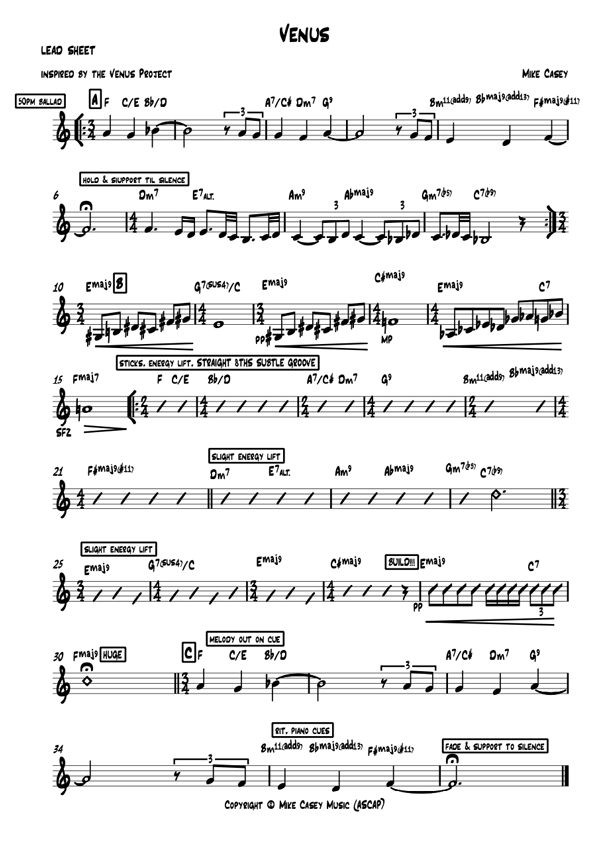Harmonic and Melodic Analysis in Modern Jazz Writing by Saxophonist Mike Casey
 In this article, we’re going to be taking deep-dive into a project me and my group recently recorded in Spain at Berklee Valencia.
In this article, we’re going to be taking deep-dive into a project me and my group recently recorded in Spain at Berklee Valencia.
The song began in spring 2018 inspired by The Venus Project, initially refined while at Boysie Lowery Jazz Residency in Wilmington, Delaware (USA) shortly before leaving for Spain. I wanted to write something as a prayer for peace and environmental sustainability, and that included some elements of European classical music (shifting time signatures, semi conducting parts of the melody and solo) and lush colorful harmony that flowed like water.
Inspiration
It all started when I watched all 3 Zeitgest documentaries (about 9 hours) on Netflix. The documentaries cover a variety of topics including origin of religion, the financial system, 9/11, government cover ups, and at the end proposes a possible way forward for humanity to become sustainable: The Venus Project.
The Venus Project is a vision for a future society, “beyond politics poverty and war”. Its founder proposes “an alternative vision of what the future can be if we apply what we already know in order to achieve a sustainable new world civilization. It calls for a straightforward redesign of our culture in which the age-old inadequacies of war, poverty, hunger, debt and unnecessary human suffering are viewed not only as avoidable, but as totally unacceptable. Anything less will result in a continuation of the same catalog of problems inherent in today’s world.”
When I saw how thorough the plan was, and the technology and philosophy behind it, I was floored. The Venus Project “lays out a sustainable world civilization where technology and the methods of science are applied to redesigning our social system with the prime concern being to maximize quality of life rather than profit. All aspects of society are scrutinized – from our values, education, and urban design to how we relate to nature and to one another.”
I was so inspired that I decided to compose a hopeful, calming ballad in its name. Initially this song was workshopped & refined while at Boysie Lowery Jazz Residency in Wilmington Delaware (USA) in June 2018 shortly before leaving for Spain. At the end of the Boysie residency I arranged it for rhythm section + string quartet, performing with some members of the Philadelphia Symphony Orchestra. Venus also features Jason Faust on piano, Issaya Rouson on drums, Ricardo Osorno on bass, was recorded, mixed and mastered by Hugh Harsher.
It made perfect sense to me to do this right now, not only because our world seems to be in a tumultuous tailspin of politics and socioeconomic/racial divide. Another source of timely inspiration entered the picture upon my arrival in Valencia, as I was blown away by the futuristic architectural aesthetic – an aesthetic which was very much in line with The Venus Project’s futuristic outlook. It felt like I was living in a future city, in a way, amongst a peaceful group of international artists (between faculty and students, people from 40 different countries coexisting and creating in one building).
Melodic Analysis
Click here for a more readable and printable PDF version of the sheet music below.

To capture the emotion of hopefulness and yearning, juxtaposed against the progressive nature of the subject, I wanted to design a prayerful melody that both uplifts the listener and makes them ponder society, even life itself. Simplicity, sing-ability, range, lyricism were key considerations. I wanted it to be as poetic as possible.
Most of the A section melody is in C major diatonic, to accomplish these goals. The rule of three (which states that a trio of events is more effective than other numbers) is at play, as the first three phrases are essentially 3 note groups. The melody starts high and slowly goes lower during the 9 bar A section, with the first 6 bars being in 3⁄4 and the last 3 being in 4/4, for a total of 30 beats (if counting in one).
I played around with many different divisions of time signature to bring out the true phrasing of the song – and found that while several worked, splitting the first 6 bars in 3 and the last 3 in 4 seemed to have a continuous flow.
On the 6 bar bridge (again with rule of threes – three 2 bar phrases), I hand off the melody temporarily to piano, amongst faster change of time signatures – one bar of 3, one bar of 4, one bar of 3, 3 bars of 4. The solo follows the form but instead of fermata in the A section I save it for the end and climax of the solo.






Moving Far Beyond Jazz with Innovative Saxophonist Mike Casey – Saxophonist.org
November 23, 2020 @ 6:41 am
[…] world, making lifelong friends that I still collaborate with (aside from Venus which BSWE covered here and was recorded at Berklee Valencia in Spain, there is another album coming from this time, along […]
Moving Far Beyond Jazz with Innovative Saxophonist Mike Casey » Best. Saxophone. Website. Ever.
December 22, 2020 @ 9:10 am
[…] world, making lifelong friends that I still collaborate with (aside from Venus which BSWE covered here and was recorded at Berklee Valencia in Spain, there is another album coming from this time, along […]